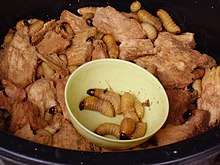Rhynchophorus vulneratus
The palm weevil Rhynchophorus vulneratus is one of two species of snout beetle known as the red palm weevil, Asian palm weevil, or Sago palm weevil. The adult beetles are relatively large, ranging between two and four centimeters long, and vary from a rusty red colour to almost entirely black; many colour variants exist and have led to considerable confusion with other species (e.g., Rhynchophorus ferrugineus). Weevil larvae of these species can excavate holes in the trunk of a palm trees up to a metre long, thereby weakening and eventually killing the host plant. As a result, these weevils are considered major pests in palm plantations, including the coconut palm, date palm and oil palm.[1]
| Rhynchophorus vulneratus | |
|---|---|
| Scientific classification | |
| Kingdom: | |
| Phylum: | |
| Class: | |
| Order: | |
| Family: | |
| Genus: | |
| Species: | R. vulneratus |
| Binomial name | |
| Rhynchophorus vulneratus (Panzer, 1798) | |
| Synonyms | |
| |
Originally from tropical Asia, this palm weevil has been recorded in the United States at Laguna Beach, CA late in 2010[2][3] but it was initially misidentified as the closely related species, Rhynchophorus ferrugineus, and it did not become established.[4]
Distribution
The native range of this species is considered to include Indonesia, Malaysia, Myanmar, Singapore, and Thailand; outside its native range it has been reported and confirmed only from the United States.[4]
Taxonomy
Primarily due to the existence of numerous color forms across their ranges, the taxonomy and classification of red palm weevils has undergone a number of changes in understanding and circumscription. As such, the information in the literature should be viewed as a compilation of data which may apply to both species, depending primarily upon the biogeography. The most recent genus-level revision in 1966[5] recognized two species of red palm weevils, ferrugineus and vulneratus, and for decades these were interpreted as separate taxa. A genetic study in 2004[6] concluded that vulneratus was not distinct from ferrugineus, and treated them as synonyms, a view that was accepted until 2013, when yet another genetic study[7] came to the opposite conclusion, based on more comprehensive geographic sampling. Accordingly, the "red palm weevil" species that appeared in the US was vulneratus rather than ferrugineus, though the latter is the invading species in all of the other global introductions.[7]
Hosts
Red palm weevils are reported to attack 19 palm species worldwide; due to the taxonomic confusion, it is unclear whether R. vulneratus and R. ferrugineus favor different hosts, though nearly all of the invasive populations known are of ferrugineus, so one of the only confirmed hosts for vulneratus outside of Asia is the Canary Island date palm, Phoenix canariensis.[4]
Culinary uses

The larval grub is considered a delicacy in Southeast Asian countries, including Brunei,[8] and Malaysian Borneo.[9][10] Sago grubs have been described as creamy tasting when raw, and like bacon or meat when cooked. They are often prepared with sago flour. The larvae are also eaten either raw or roasted in Malaysian Bornean states of Sabah and Sarawak, and regarded as a special high-nutrient meal among the natives there like the Kadazan-Dusun, Melanau and the Dayak.[10][11] In Sabah the dish is called butod.[12]
References
- Rhynchophorus ferrugineus at North American Plant Protection Organization (NAPPO)
- Orange County Register, "Destructive exotic beetle found in Laguna Beach."
- CDFA; Red Palm Weevil, Worst Known Pest of Palm Trees Detected in Laguna Beach
- Hoddle et al. (2017) The palm weevil Rhynchophorus vulneratus is eradicated from Laguna Beach. California Agriculture 71(1): 25-29
- Wattanapongsiri, A. 1966. A revision of the genera Rhynchophorus and Dynamis (Coleoptera: Curculionidae). Department of Agriculture Science Bulletin 1: 1-328
- Hallett, R.H., Crespi, B.J., Borden, J.H. 2004. Synonymy of Rhynchophorus ferrugineus (Olivier), 1790 and R. vulneratus (Panzer), 1798 (Coleoptera, Curculionidae, Rhynchophorinae). J. Nat. Hist. 38:2863-2882
- Rugman-Jones, P.F., C.D. Hoddle, M.S. Hoddle, R. Stouthamer. 2013. The Lesser of Two Weevils: Molecular-genetics of pest palm weevil populations confirm Rhynchophorus vulneratus (Panzer 1798) as a valid species distinct from R. ferrugineus (Olivier 1790), and reveal the global extent of both. PLoS One. 2013; 8(10): e78379. doi: 10.1371/journal.pone.0078379
- "Food documentary showcases Bruneian cuisines". 2 January 2019. Retrieved 13 September 2019.
- Adam Leith Gollner (11 June 2013). The Fruit Hunters: A Story of Nature, Adventure, Commerce, and Obsession. Simon and Schuster. pp. 86–. ISBN 978-1-4767-0499-9.
- Tamara Thiessen (5 January 2016). Borneo. Bradt Travel Guides. pp. 190–. ISBN 978-1-84162-915-5.
- Kuan Leong Yew; Victoria Shinq Ling Kok (2012). "Exotic Food Anaphylaxis and the Broken Heart: Sago Worm and Takotsubo Cardiomyopathy" (PDF). Heart Centre, Sarawak General Hospital, Sarawak, Malaysia. Archived from the original (PDF) on 7 October 2016. Retrieved 7 October 2016.
- Anna Vivienne (3 September 2012). "Magahavat: Celebrating sago". The Borneo Post. Retrieved 7 October 2016.
Additional resources
| Wikispecies has information related to Rhynchophorus vulneratus |